Mechanisms of Dihuang (Rehmanniae Radix) in treating diabetic nephropathy complicated with depression based on network pharmacology
LEI Xing,CHEN Qingyo,WANG Xioping,XU Jie,GAO Yzhen,LIN Qiohong,YE Zuwen,ZHANG Jieyn,SI Qin*,WANG Fng*
a. Key Laboratory of Modern Traditional Chinese Medicine Preparation,Ministry of Education,Jiangxi University of Chinese Medicine,Nanchang,Jiangxi 330004,China
b. Pharmacy Department,Zhangzhou Health Vocational College,Zhangzhou,Fujian 363000,China
c. School of Agro-Industry,Mae Fah Luang University,Muang,Chiang Rai 57100,Thailand
ABSTRACT Objective To predict the molecular mechanism of Dihuang (Rehmanniae Radix) in the treatment of diabetic nephropathy (DN) complicated with depression based on network pharmacology.Methods The components of Dihuang (Rehmanniae Radix) were identified from the Integrated Pharmacology-based Research Platform of Traditional Chinese Medicine (TCMIP),Traditional Chinese Medicine Systems Pharmacology Database and Analysis Platform (TCMSP),and relevant literature. The component targets were detected by combining the SwissTarget-Prediction and PubChem databases. Disease targets were collected from the Therapeutic Target Database (TTD),DisGeNET,and Ensembl databases with “diabetic nephropathy” and“depression” as keywords. The disease-component targets were mapped using Venny 2.1.0 to obtain potential targets. A protein-protein interaction (PPI) network was constructed using the Search Tool for the Retrieval of Interacting Genes/Proteins (STRING) database and Cytoscape 3.7.2. The co-expression genes of the key targets were collected based on the COXPRESdb 7.3. Gene Ontology (GO) and Kyoto Encyclopedia of Genes and Genomes (KEGG) enrichment analysis were performed for potential targets using R language. Target-component docking was verified and evaluated using Discovery Studio 4.5.Results According to the databases and literature reports,Dihuang (Rehmanniae Radix) contained 65 active components,and had 155 related targets for the treatment of DN complicated with depression. PPI screening showed that the key targets included serine/threonine protein kinase 1 (AKT1),signal transducer and activator transcription 3 (STAT3),interleukin 6(IL-6),mitogen-activated protein kinase 1 (MAPK1),and vascular endothelial growth factor A(VEGFA),etc. GO enrichment analysis mainly involved biological processes,such as lipid metabolism,protein secretion regulation,cell homeostasis,and phosphatidylinositol 3 kinase activity. KEGG pathway enrichment analysis included the role of the AGE-RAGE signaling pathway in diabetic complements,insulin resistance (IR),neurotrophin signal path,Toll-like receptor signaling pathway,relaxin signaling pathway,epidermal growth factor receptor tyrosine kinase inhibitors (EGFR-TKIs),etc. Molecular docking showed that the target had high affinity for stachyose,manninotriose,verbascose,nigerose,etc.Conclusion Based on network parmacology,this study preliminarily predict the effects of Dihuang (Rehmanniae Radix) in treating DN complicated with depression by regulating inflammation,glucose metabolism,nution nerve,etc.
Keywords Dihuang (Rehmanniae Radix) Diabetic nephropathy Depression Network pharmacology Molecular docking Simultaneous treatment of different diseases True deficiency with false excess patterns Inflammation
1 Introduction
Dihuang (Rehmanniae Radix) is the fresh or dry root tuber ofRehmannia glutinosaLibosch.[1],which was first recorded inShennong's Classic of Materia Medica(Shen Nong Ben Cao Jing,《神农本草经》) and was listed as the top grade[2].Famous Doctors(Ming Yi,《名医》)says: “Dihuang (Rehmanniae Radix) is found earlier in Xianyang,with the better in yellow earth. Roots are picked and dried in the shade on February 8 of the lunar calendar”; it is mainly distributed in Henan,Hebei,Shandong,Shanxi,etc.,withRehmannia glutinosafrom Huaiqing House (the present Jiaozuo in Henan Province)as the most valuable[3].Compendium of Materia Medica(Ben Cao Gang Mu,《本草纲目》) records: “Dihuang(Rehmanniae Radix),which is planted with yellow earth in Jiangsu and Zhejiang,appears good but shows mild effects due to southern Yang Qi,Huai Dihuang (Rehmanniae Radix from the ancient Huaiqing House),appears coarse with knots but shows strong effects due to the northern pure Yin Qi”[4]. The medicinal history of China has reported freshRehmannia glutinosa,rawRehmannia glutinosa,and preparedRehmannia glutinosa[5-8]. Extensive research has been recently conducted on the components of Dihuang (Rehmanniae Radix),which mainly include iridoids,saccharides,glycosides,amino acids,etc. Dihuang (Rehmanniae Radix) has the effects of clearing heat and cooling blood,nourishing Yin and tonifying the kidney,and reinforcing essence and supplementing marrow. It has beneficial effects on improving glucose and lipid metabolism,improving vascular endothelial function,reducing oxidative stress in cells,increasing immunity,and inhibiting inflammatory factors[3,9-11].
Diabetic nephropathy (DN) is a microvascular complication with high incidence in patients with diabetes mellitus (DM),and is categorized as “diabetes” “edema”“clearance” and “fatigue” in traditional Chinese medicine (TCM)[12]. According to the epidemiological prediction,approximately 592 million patients will be diagnosed with DM worldwide in 2035[13],and approximately one third of the patients with diabetes will develop DN[14,15]. In the past 30 years,the incidence of DN in China has increased from 2.7% to 35.2%[16],and it has become the primary cause of end-stage renal injury[17]. Depression is a mental disorder characterized by obvious and lasting mental symptoms,which is categorized as“depression” “dirty mania” and “lily disease” in TCM.The occurrence of DN is closely related to depression[18].According to the statistics,the risk of diabetes in patients with depression is two times higher than that in healthy people[19],and the detection rate of DN complicated with depression is 53%[20]. Compared with a single disease,comorbidity is rarely studied. The impacts of DN and depression are superimposed,and the disease recognition and treatment rates are low,which greatly increases the mortality and disability rates[21]. At present,the therapeutic effect of western medicine is still not ideal. In contrast,the multi-target,multi-level,and multi-axis therapeutic characteristics of Chinese medicines,and the feasibility of comprehensive intervention make it the key researching area[22]. DN complicated with depression is closely related to a decrease in glomerular filtration rate,insulin resistance (IR),neuroendocrine dysfunction,and inflammation[23,24]. Heary and lasting depression aggravates DN,accelerates the disease process,and increases the mortality[25]. Professor RUAN Shiyi,a master of TCM,once thought that the source of depression lied in the kidney based on the theory of “heart-liver-kidney integration”,and that depression could be treated by “nourishing Yin and tonifying the kidney”[26]. Dihuang (Rehmanniae Radix) is one of the core drugs in the Baihe Dihuang Decoction (百合地黄汤),a classic antidepressant prescription. Dihuang (Rehmanniae Radix) mainly lowers apoptosis and neuronal damage to exert antidepressant effects by regulating neurotransmitters and their receptors,attenuating inflammation,and improving metabolism[27-29]. TCM formulae,such as Liuwei Dihuang Pill (六味地黄丸),are commonly used in clinical practice to treat DN,improve the disorders of glucose and lipid metabolism,and lower the level of nuclear factor-κB (NF-κB) and cell adhesion factor-1 to reduce urinary protein excretion and alleviate renal inflammatory reactions[30,31]. Therefore,TCM compounds are clinically used to manage comorbidity with psychotherapy[32,33]. At present,the mechanism of Dihuang (Rehmanniae Radix) in treating DN complicated with depression is not fully understood. This study aims to preliminarily predict the mechanism of Dihuang (Rehmanniae Radix) in treating DN complicated with depression based on network pharmacology. Figure 1 shows the overall design of this study.
2 Methods
2.1 Collecting and screening disease targets
“Diabetic nephropathy” and “depression” were utilized as keywords to search in Therapeutic Target Database(TTD) (http://db.idrblab.net/ttd/),DisGeNET database(https://www.disgenet.org/search),and Ensembl database (https://uswest.ensembl.org/index.html).

Figure 1 Research process of Dihuang (Rehmanniae Radix) in treating DN complicated with depression
2.2 Collecting and screening the components of Dihuang(Rehmanniae Radix)
The components of Dihuang (Rehmanniae Radix) were collected from the Integrated Pharmacology-based Research Platform of Traditional Chinese Medicine(TCMIP) 2.0 (http://www.tcmip.cn/TCMIP/index.php/Home/),and the Traditional Chinese Medicine Systems Pharmacology Database and Analysis Platform (TCMSP)(http://tcmspw.com/tcmsp.php). Considering that some active components were not included in the database,relevant literature on Dihuang (Rehmanniae Radix) in the last five years was retrieved to supplement.
2.3 Screening and predicting potential component targets of Dihuang (Rehmanniae Radix)
Based on the active components collected above,the relevant component targets of Dihuang (Rehmanniae Radix) were collected from the TCMIP 2.0,TCMSP,Pub-Chem (https://pubchem.ncbi.nlm.nih.gov/),and Swiss-TargetPrediction (http://swisstargetprediction.ch/) databases. Venny 2.1.0 (https://bioinfogp.cnb.csic.es/tools/venenny/index.html) was used to map the components and disease targets.
2.4 Protein-protein interaction (PPI) network analysis
The information on intersection targets was imported into the Search Tool for the Retrieval of Interacting Genes/Proteins (STRING) database (https://string-db.org/). The screening index was set as confidence ≥ 0.700.The data were updated and saved in “.tsv” format. The information of node #1 and node #2,and the combined score were imported into Cytoscape 3.7.2. The network targets were topologically analyzed,and the targets with a degree value greater than two times the median were selected as key targets. COXPRESdb 7.3 database(https://coxpresdb.jp/) was used to search for genes strongly expressed at the key targets.
2.5 Pathway enrichment analysis
Gene Ontology (GO) and Kyoto Encyclopedia of Genes and Genomes (KEGG) pathway enrichment analysis were carried out to identify the potential targets of Dihuang(Rehmanniae Radix) in treating DN complicated with depression using R language (clusterProfiler package). The relationship between the top 20 KEGG pathways and the active components and the potential targets of Dihuang(Rehmanniae Radix) was visualized using Cytoscape 3.7.2 software.
2.6 Molecular docking
The molecular docking software,Discovery Studio 4.5,was used to verify the docking of the top five targets of degree in topological analysis. Using the RCSB Protein Data Bank (PDB) database (http://www.rcsb.org/) and the DrugBank database (https://www.drugbank.com/),the target protein structure was screened as the counter receptor,and the listed drugs were selected as positive controls according to the target protein. In this study,valsartan and fluoxetine were selected as positive drugs for DN and depression[34,35]. The two dimensional (2D)chemical structure of TCM components,valsartan,and fluoxetine,were obtained from PubChem (https://pubchem.ncbi.nlm.nih.gov/) database. The larger the docking score,the more stable the binding.
3 Results
3.1 Screening key targets
Based on TCMIP 2.0,TCMSP database,and literature reports,65 active components of Dihuang (Rehmanniae Radix) were identified. From the collected targets in the database,703 active component targets of Dihuang(Rehmanniae Radix),1 297 DN-related targets,and 1 735 depression-related targets were identified. Venny 2.1.0 tool was used to map Dihuang (Rehmanniae Radix) components,DN,and depression targets. A total of 155 potential targets were obtained by intersection (Figure 2),which showed that Dihuang (Rehmanniae Radix) treats DN and depression through the same mechanism.

Figure 2 Potential targets of Dihuang (Rehmanniae Radix) in treating DN complicated with depression
3.2 Analysis of intersection targets PPI and co-expression gene network
A total of 155 potential targets were imported into the STRING database combined with the Cytoscape 3.7.2,33 key targets were screened with degree values greater than two times the median (degree > 16). As shown in Table 1,the top five were serine/threonine protein kinase 1(AKT1),signal transducer and activator transcription 3(STAT3),interleukin-6 (IL-6),mitogen-activated protein kinase 1 (MAPK1),and vascular endothelial growth factor A (VEGFA). PPI network is shown in Figure 3. The co-expression genes of the 33 key targets were searched using the COXPRESdb 7.3 database. The first three strongly expressed genes were selected,and 47 co-expressed genes were obtained,which were introduced into Cytoscape 3.7.2. With the help of 12 network structures (e.g. MCC,DMNC,MNC,and degree in the plug-in cytoHubba and the weighted algorithm between nodes),the top five hub genes (key genes) were identified,namely tumor necrosis factor (TNF),matrix metalloproteinase-2 (MMP2),chemokine ligand 3 (CCL3),macrophage inflammatory protein 1β(CCL4),and type III collagen (COL3A1).
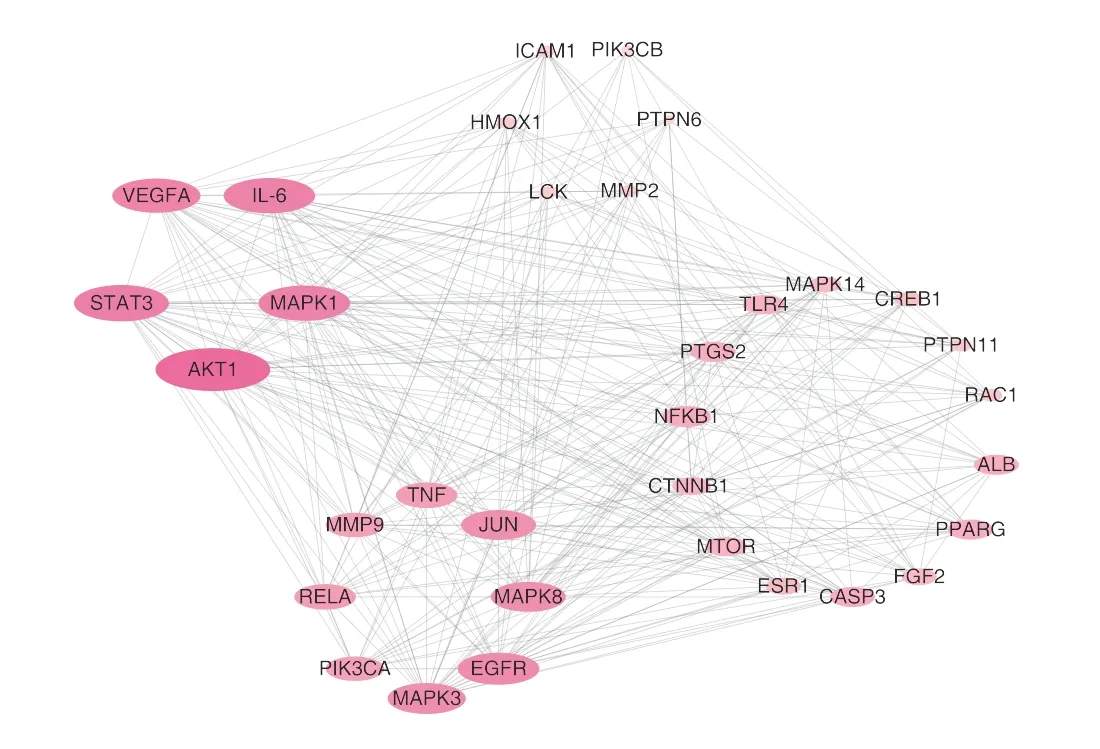
Figure 3 PPI network of Dihuang (Rehmanniae Radix) in treating DN complicated with depression
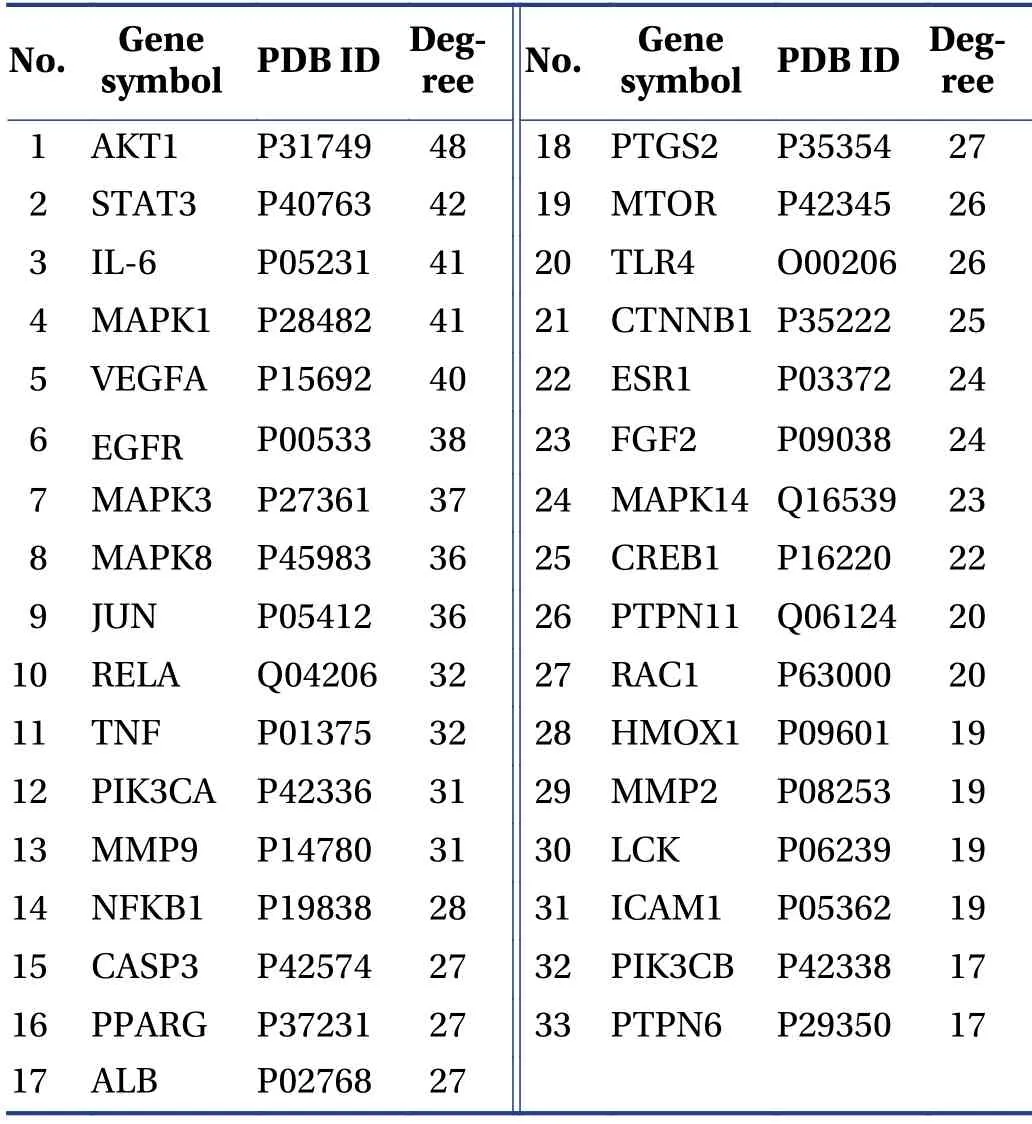
Table 1 Key target information in PPI network
3.3 GO and KEGG pathway enrichment analysis
To further explore the mechanism of Dihuang (Rehmanniae Radix) in treating DN complicated with depression,gene annotation and pathway analysis of mapping targets were carried out using R language. GO function enrichment analysis showed enrichment of 2 581 items (P<0.05),including 2 365 biological processes (BP),namely the regulation of lipid metabolism,protein secretion,cell homeostasis,response to oxygen level,smooth muscle cell proliferation,etc. A total of 151 molecular functions(MF) were identified,including protein serine/threonine kinase activity,protein phosphatase binding,transmembrane receptor protein tyrosine kinase activity,nuclear receptor transcription coactivator activity,phosphatidylinositol 3 kinase activity (PI3K),etc. A total of 65 cell components (CC) were identified. They were related to glutamatergic synapses,phosphatidylinositol 3 kinase complexes,nuclear transcription factor complexes,secretory granule lumens,etc. The top 20 pathways based on these three aspects were selected for the graphic display (Figure 4). These results showed that the active components of Dihuang (Rehmanniae Radix) could play a therapeutic role in DN complicated with depression by regulating various biological pathways.
A total of 171 entries were obtained by enrichment analysis of KEGG pathway (P< 0.05). The enriched pathways included AGE-RAGE signaling pathway,IR,Toll-like receptor signaling,neurotrophic factor signaling pathway,C-type lectin receptor signaling pathway,chalasin signaling pathway,epidermal growth factor receptor tyrosine kinase inhibitors (EGFR-TKIs),endocrine resistance,TNF signaling pathway,HIF-1 signaling pathway,apoptosis,etc. The KEGG Mapper tool[36]was used to integrate the screened important pathways with key targets,including oxidative stress,glucose metabolism,apoptosis,inflammatory reactions,etc. (Figure 5). According to thePvalue,the top 20 pathways were plotted with the corresponding component-target-pathway diagram (Figure 6). From the component-target-pathway diagram,we found class I phosphatidylinositol 3-kinase (PIK3CA),AKT1,phosphatidylinositol 4,5-diphosphate 3-kinase catalytic subunit delta (PIK3CD),protein kinase Cα(PRKCA),MAPK1,phosphatidylinositol 3-kinase catalytic subunitβ(PIK3CB),mitogen-activated protein kinase 3(MAPK3),etc. appear frequently. On analyzing the component-target-pathway diagram,it was found that,among the active components of Dihuang (Rehmanniae Radix),one active component could act on multiple targets at the same time,and one target also corresponded to a variety of active components. This proves that the active components of Dihuang (Rehmanniae Radix)could play a therapeutic role in multiple components and targets,and the possible relationship among Chinese medicines,diseases,and targets can be effectively predicted. In addition,the complex network diagram indirectly reflected the complexity of the interactions between drugs. Figure 6 shows 52 targets related to the active components of Dihuang (Rehmanniae Radix) and 75 potential targets in the top 20 pathways. Targets with higher frequencies were directly or indirectly involved in the AGE-RAGE signaling pathway in diabetic complications,the TNF signaling pathway,and the HIF-1 signaling pathway. Among them,the AGE-RAGE signaling pathway in diabetic complications involves the phosphatidylinositol 3-kinase/protein kinase B (PI3K/Akt) signaling pathway,which is a key pathway affecting insulin-mediated hypoglycemic effects and is abnormally regulated in patients with DN. IR can induce mitochondrial dysfunction and various neurotransmitters,and aggravate neuronal damage. Improving IR can reverse the depression-like behavior in rats with DN[22]. Thus,modulation of this pathway has a positive impact on treating DN complicated with depression.

Figure 4 GO functional enrichment analysis of potential targets of Dihuang (Rehmanniae Radix) in treating DN completed with depression
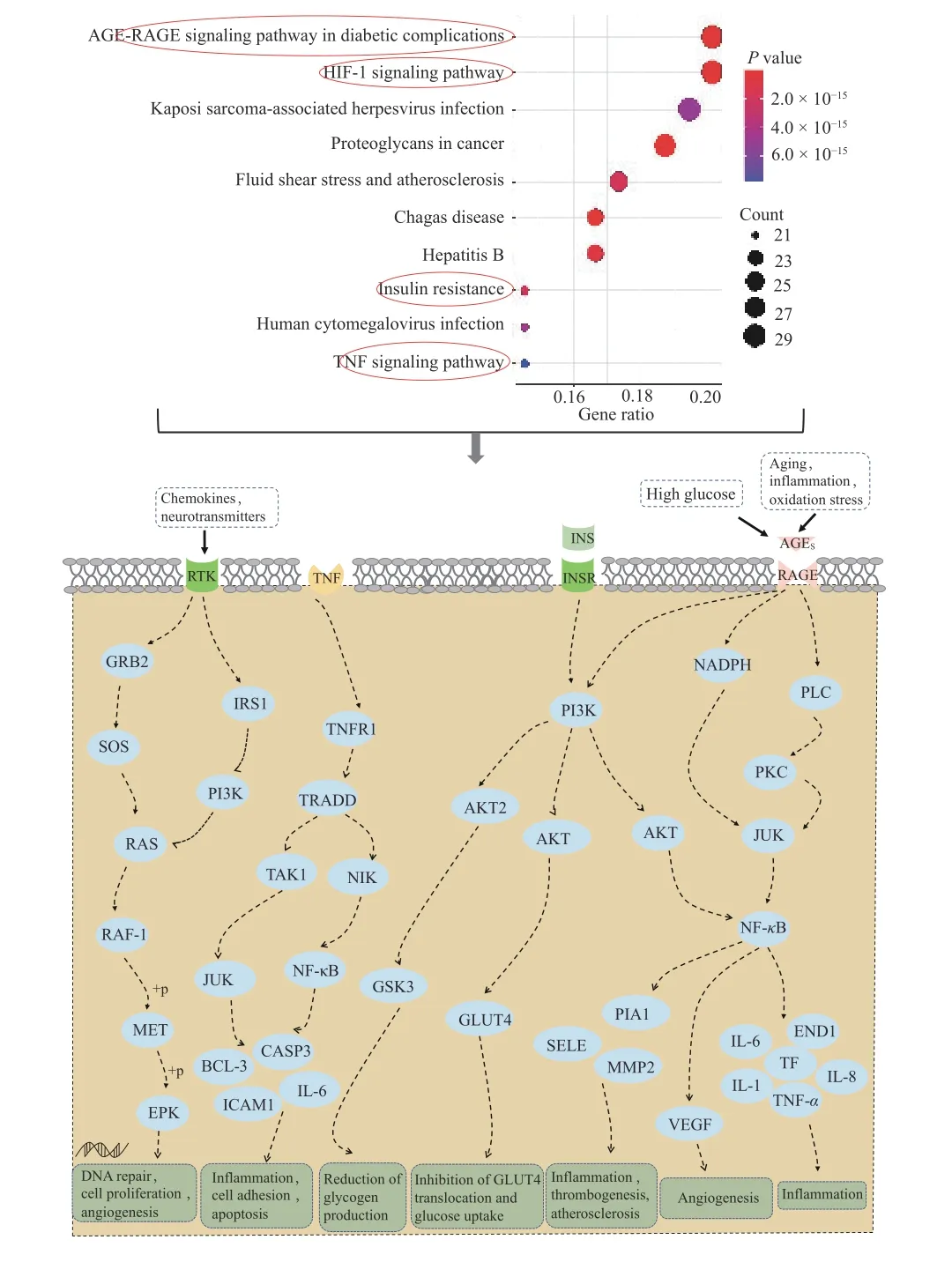
Figure 5 Path map of Dihuang (Rehmanniae Radix) in treating DN complicated with depression

Figure 6 Component-target-pathway map of Dihuang (Rehmanniae Radix) in treating DN complicated with depression DH represents Dihuang (Rehmanniae Radix).
3.4 Molecular docking results
Based on the top five targets in the PPI network,the corresponding target protein receptors were downloaded from the RCSB PDB database: AKT1 (PDB ID 2GHG),STAT3 (PDB ID 5AX3),IL-6 (PDB ID 4QIL),MAPK1 (PDB ID 60PI),and VEGFA (PDB ID 4ZFF). The targets were verified with the positive drugs valsartan and fluoxetine,and the corresponding Chinese medicine components.The docking results are presented in Table 2. The higher the docking fraction,the better the binding activity between the target protein and the effective chemical components,and the closer it is to the docking value of the positive drugs. Stachyose,maninotriose,verbasose,and nigerose exhibited higher affinities in the docking process.
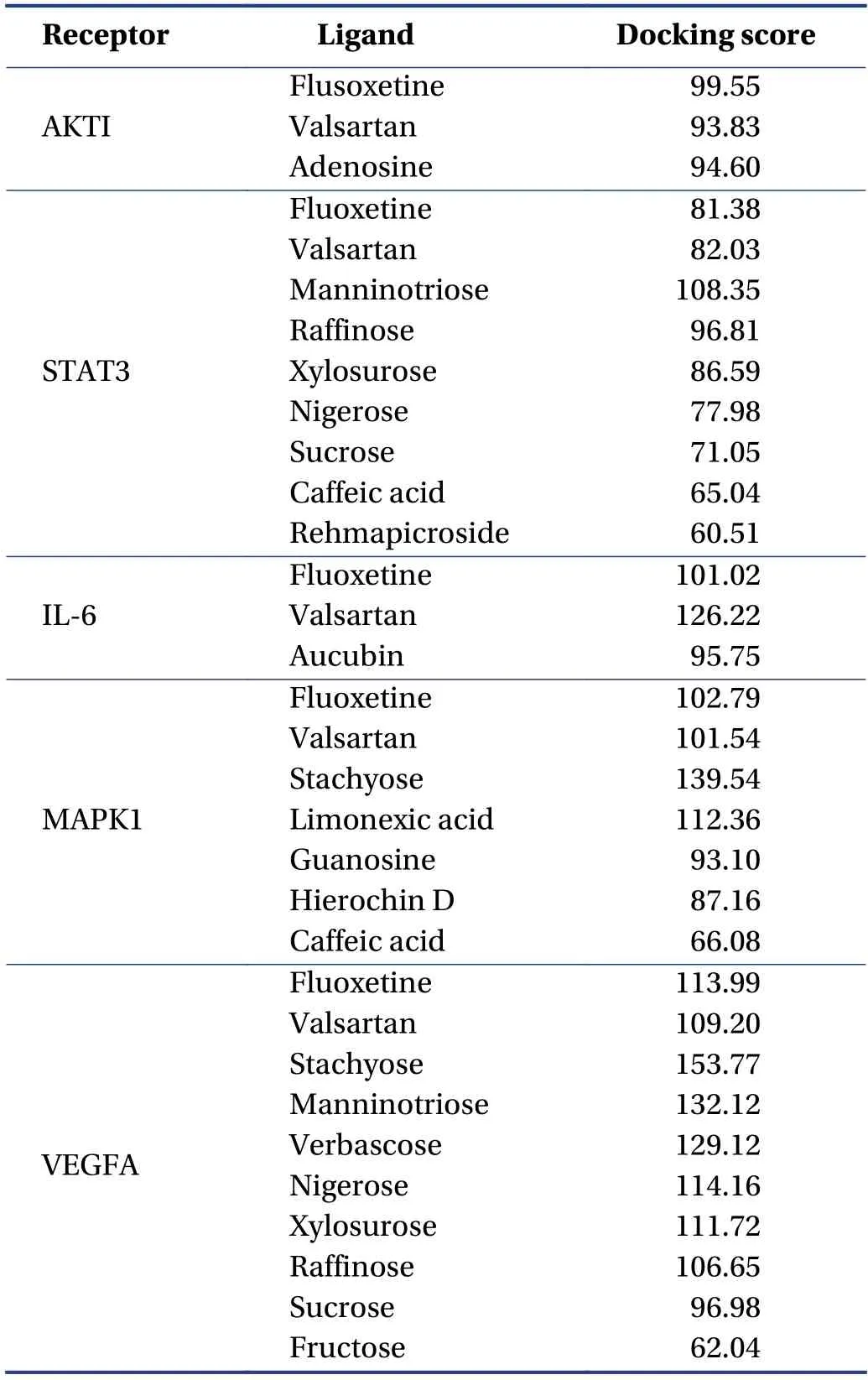
Table 2 Target docking results of Dihuang (Rehmanniae Radix) in treating DN complicated with depression
4 Discussion
In TCM theory,the basic pathogenesis of “diabetes” combined with “depression” is “true deficiency with false excess patterns”. The former is based on deficiency of zang and fu organs,whereas the latter is based on phlegm coagulation,Qi stagnation,and blood stasis[18].Medical Classic based on Confucianism(Ru Men Shi Qin,《儒门事亲》) records: “Disease,without controlling sleep or emotion activities,would reoccur even though it's cured for a while”. It indicates that diabetes and depression inreract as both cause and effect,usally occruing together. According to the domestic report,the incidence of diabetes complicated by depression can reach 26% -58%[37].The Key to Syndrome and Treatment(Zheng Zhi Yao Jue,《证治要诀》) records: “For patients withprolonged diabetes,the urine smells sweet instead of unpleasant; without proper treatment,kidney essence would be exausted”. Physicians generally emphasize that the course of DN is long,which easily leads to poor medication compliance,and is then complicated with depression[38]. Dihuang (Rehmanniae Radix) has the effects of clearing heat and cooling blood,nourishing Yin and tonifying the kidney,and reinforcing the essence and supplementing marrow. Clinically,Dihuang (Rehmanniae Radix) is often used to treat DN and depression in TCM. Dihuang (Rehmanniae Radix) can substantially reduce the expression of the growth factor receptor binding protein 10 (GRB 10) and advanced glycation end products receptor (RAGE),improve lipid metabolism,reduce microangiopathy,and interfere with inflammatory reactions,thus treating DN successfully[31]. It can also treat depression by protecting neurons,promoting neuron regeneration,and regulating monoamine neurotransmitter content[27,39].
This study identified 65 active components of Dihuang (Rehmanniae Radix) corresponding to 703 targets,of which 155 targets were related to DN and depression.PPI analysis of potential targets of Dihuang (Rehmanniae Radix) in treating DN complicated with depression showed that AKT1,STAT3,IL-6,MAPK1,VEGFA,etc. were highly enriched. A total of 47 co-expressed genes were found from the 33 key targets in PPI,and the top five hub genes co-expressed were TNF,MMP2,CCL3,CCL4,and COL3A1. AKT1 is a subtype of protein kinase B,which is a serine/threonine kinase involved in intracellular signal transduction and participates in the signaling pathways of neurotransmitters such as brain-derived neurotrophic factor (BDNF),nerve growth factor (NGF),5-hydroxytryptamine (5-TH),and dopamine (DA). The improvement in patients with depression is positively correlated with the change in AKTI expression[40]. MMP2 can cause anticoagulation system disorder,accelerate renal vascular calcification[41],and target STAT3,IL-6,MAPK1,TNF,CCL3,and CCL4,which can mediate the activation of inflammatory factors,chemokines,and adhesion factors to a certain extent,and then play a proinflammatory role. The inflammatory cytokine IL-6 phosphorylates and activates STAT3,and the target gene of STAT3 overlaps with the target gene of the NF-κB signaling pathway. Monocytes are induced to release chemokines such as CCL3 and CCL4 by activating the NF-κB signaling pathway[42]. Modern molecular biology and genetics research confirmed the relationship between depression and immune system regulation,and research showed that abnormal levels of peripheral proinflammatory factors such as IL-6,IL-1β,and TNF-αwere detected in the sera of patients with depression[43]. Inflammatory reactions can downregulate BDNF expression,damage hippocampal neurons,and induce depression[44]. Inflammation is also an important mechanism for the development of DN[45]. Augmented levels of TNF-αor IL-6 decrease the expression of thrombomodulin(CD141),which inhibits the onset of renal failure caused by anticoagulation[46]. Meanwhile,the migration and release of inflammatory factors accelerate the apoptosis of glomerular endothelial cells,increase the permeability of endothelial cells,cause proteinuria[47],and aggravate the progression of DN. Several targets related to immune system regulation have been elucidated in the present study. In summary,Dihuang (Rehmanniae Radix) can protect the kidney and hippocampus by reducing inflammation.
GO enrichment analysis showed that Dihuang(Rehmanniae Radix) was mainly involved in regulating lipid metabolism,protein serine/threonine kinase activity,phosphotyrosine residue binding,nuclear receptor transcription coactivator activity,PI3K,protein secretion,and glutamatergic synapses,etc. Depression can increase platelet activation and blood viscosity[48]. Regulating lipid metabolism can inhibit platelet aggregation,reduce blood viscosity,and improve blood circulation of the glomerular capillaries[49],thus affecting the development of DN complicated with depression. Insulin stimulates the phosphorylation of tyrosine residues by activating the insulin receptor (tyrosine kinase receptor),promotes the cellular uptake and utilization of glucose through insulin receptor substrate-1/phosphatidylinositol-3 kinase/glucose transporter 4 (IRS-1/PI3K/GLUT4),and participates in the regulation of blood glucose[50-52].Therefore,the effect of Dihuang (Rehmanniae Radix) on DN complicated with depression is closely related to the regulation of blood glucose. DING et al.[53]reported that glutamate levels and the glutamine/glutamate ratio in depressed mice increased,glutamine levels decreased,and glutamate levels were reversed after administration of antidepressants.
KEGG pathway enrichment analysis showed that the related component targets of Dihuang (Rehmanniae Radix) were involved in the AGE-RAGE signaling pathway in diabetes complicated with depression,IR,neurotrophic factor signaling pathway,Toll-like receptor signaling,C-lectin receptor signaling pathway,relaxin signaling pathway,EGFR-TKIs,etc. Upregulation of the AGE-RAGE signaling pathway can increase the number of proinflammatory and profibrotic cytokines and activate oxidative stress and apoptosis,leading to renal failure[54]. The combination of AGES and RAGE can activate the PI3K/Akt signaling pathway,which is the key pathway for insulin to regulate blood glucose[55]. Glycolipid accumulation caused by IR can have toxic effects on podocytes and glomerular filtration membrane,and participate in early diabetic kidney damage[52]. Toll-like receptors widely exist on the surface or inside the immune regulatory cells and immune effector cells[56]. Toll-like receptors bind to ligands,activate the nuclear transcription factor NF-κB,and induce an increase in inflammatory factors and chemokines[57]. Meanwhile,podocytes and renal tubular epithelial cells in high glucose environments can accelerate the activation of Toll-like receptors,and aggravate DN-mediated inflammation and renal fibrosis[58,59]. The neurotrophic factor hypothesis is one of the mechanisms that underly the pathogenesis of depression. BDNF is closely related to neuronal growth,apoptosis,human emotions,and cognitive function[60]. EGFRTKIs can regulate cell growth and inhibit intimal hyperplasia[61]. The core targets of these pathways are related to the active components of Dihuang (Rehmanniae Radix),and play an important role in the treatment of DN complicated with depression.
5 Conclusion
The active components of Dihuang (Rehmanniae Radix)maybe play a potential therapeutic role in DN complicated with depression by regulating glucose and lipid metabolism,oxidative stress,inflammatory reactions,endothelial cell apoptosis,vascular microcirculation,and nerve nourishment. Based on the complex mechanism of Dihuang (Rehmanniae Radix),the authors will conduct a follow-up study for experimental verification,such as material basis-pharmacodynamic evaluation-metabolomicspathway verification of Dihuang (Rehmanniae Radix).
Fundings
National Natural Science Foundation of China(81960714),and Jiangxi University of Chinese Medicine Graduate Innovation Project (JZYC21S52).
Competing interests
The authors declare no conflict of interest.
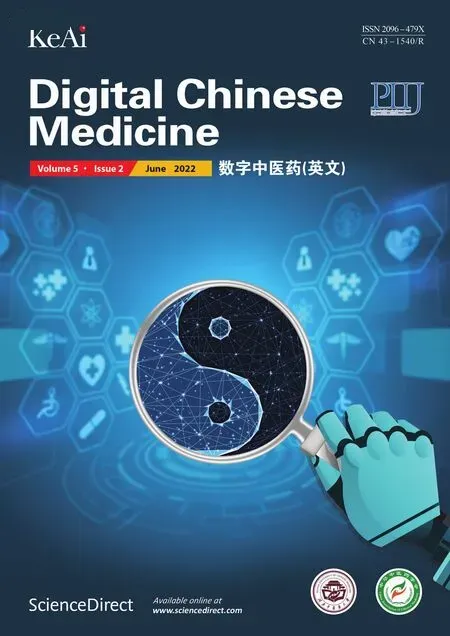 Digital Chinese Medicine2022年2期
Digital Chinese Medicine2022年2期
- Digital Chinese Medicine的其它文章
- Instructions for Authors
- Protective effects of Zuogui Jiangtang Jieyu Formula on hippocampal neurons in rats of diabetes complicated with depression via the TRP/KYN metabolic pathway
- Immunomodulatory effect of pachymaran on cyclosporine A (CsA)-induced lung injury in mice
- Preventive and therapeutic effects of Aerva lanata (L.) extract on ethylene glycolinduced nephrolithiasis in male Wistar albino rats
- Extraction process in Chuantieling (CTL) based on the quality by design (QbD)concept
- Screening influencing factors of blood stasis constitution in traditional Chinese medicine
